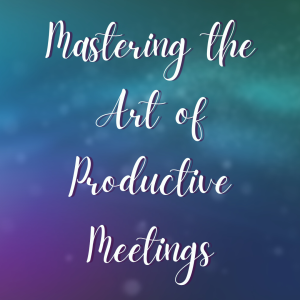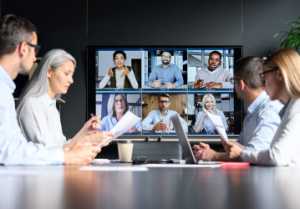 Enabling productive meetings is an art we can all adopt. In today’s fast-paced business world, the demands of professional life can often leave us feeling overwhelmed and stressed. The never-ending cycle of meetings can be a significant contributor to this stress, especially when they are unproductive and time-consuming. As a well-being and stress coach, I’m here to share some valuable insights and strategies that will help you transform your meetings into efficient, well-structured, and productive sessions, ultimately enhancing your overall well-being. Let’s explore these time-saving strategies that will make your meetings a breeze!
Enabling productive meetings is an art we can all adopt. In today’s fast-paced business world, the demands of professional life can often leave us feeling overwhelmed and stressed. The never-ending cycle of meetings can be a significant contributor to this stress, especially when they are unproductive and time-consuming. As a well-being and stress coach, I’m here to share some valuable insights and strategies that will help you transform your meetings into efficient, well-structured, and productive sessions, ultimately enhancing your overall well-being. Let’s explore these time-saving strategies that will make your meetings a breeze!
I have lived experience of when life gets overwhelming, having been off with burn-out in 2011. I was off for six months. Many of the tools and techniques I share in my posts and blogs are the tools and techniques I learned that helped me on my road to recovery.
Set Clear Agendas and Circulate Pre-Read
One of the most common reasons why meetings become a waste of time is the absence of a clear agenda. Without a well-defined purpose and a list of discussion topics, meetings tend to drift off course, leading to confusion and frustration among participants. To ensure productive meetings, I advocate for setting clear agendas for all meetings. An agenda not only keeps everyone on track but also helps in identifying whether the meeting is truly necessary. It helps decide who needs to attend too.
Before the meeting, take a moment to prepare an agenda that outlines the objectives, topics to be discussed, and the desired outcomes. Distribute this agenda to all participants in advance to ensure that everyone is well-prepared and knows what to expect. This simple step can significantly reduce the time wasted on irrelevant or off-topic discussions, contributing to a more efficient use of your valuable time.
If you want input from people, send around anything you want anyone to read at least a week ahead of the meeting. This is especially important for introverts. Introvert does not mean shy, introverts just need more time to think about things before they respond. So any preparation you can send in advance will help everyone prepare and ensure that all your team have something valuable to add.
Implement Time Limits
Time constraints are another essential component of successful meetings. Without time limits, discussions can drag on endlessly, leading to frustration and reduced productivity. I emphasise the importance of setting specific time limits for each agenda item.
Set the meeting for 50 minutes, not 60. Allow people time between meetings for a cup of tea, a bathroom break, or just a few minutes to arrange their thoughts and be ready for the next one.
For instance, if you have five agenda items for a fifty-minute meeting, allocate a specific time frame to each item. Stick to these time limits, and if necessary, defer unresolved topics to future meetings or allow people to delve deeper offline or in a meeting with fewer people. This practice not only ensures that meetings stay on track but also respects the time and energy of all participants. It allows them to plan their schedules better and be more present during the meeting, ultimately reducing stress and promoting overall well-being.
Embrace Technology
In today’s digital age, there are numerous technological tools available to help streamline meetings. From video conferencing platforms to collaborative document sharing, these tools can significantly enhance the efficiency of your meetings. As a well-being coach, I encourage you to embrace technology and leverage it to your advantage.
Use video conferencing for remote participants, which can save travel time and reduce stress associated with commuting. Utilise document-sharing and collaboration tools to keep everyone on the same page and foster productive discussions. Experiment with meeting scheduling and planning software that can automate the process, leaving you with more time to focus on the content of the meeting and your well-being.
Encourage Active Participation
To make your meetings not only efficient but also engaging, foster a culture of active participation. As a well-being coach, I firmly believe that active participation can reduce stress levels and create a more inclusive environment.
Encourage all participants to contribute their ideas and opinions. Assign roles, such as a timekeeper or note-taker, to keep the meeting organized. By involving everyone and making them feel valued, you create a more enjoyable and less stressful meeting experience. Adopt ways of including people who are less inclined to speak out in a meeting. Use anonymous polling in Zoom for example, to capture feedback. Make use of the whiteboard and let everyone annotate. Use a Google doc that everyone can contribute to. It anonymises the names.
 Review and Reflect
Review and Reflect
After each meeting, take a moment to review its effectiveness. I suggest reflecting on what went well and what could be improved. This practice helps you fine-tune your meeting strategies over time, making them more efficient and less stressful.
Consider sending out a brief post-meeting survey to gather feedback from participants. This not only shows that you value their input but also provides valuable insights into how to continually improve your meetings.
Mastering the art of productive meetings is not only about saving time but also reducing stress. By setting clear agendas, implementing time limits, embracing technology, encouraging active participation, and regularly reviewing and reflecting on your meeting practices, you can significantly reduce stress and make your professional life more enjoyable and rewarding. I am here to support you on this journey to more efficient and stress-free meetings. Remember, your time is precious, and it’s up to you to make the most of it!



